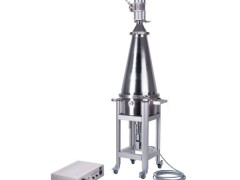MicroPlastic Sediment Separator MPSS
Density Separation of Microplastic Particles
from Sediment Samples
Although plastic debris is constantly accumulating in aquatic environments, its impact is not yet fully understood. The establishment of a reliable, verified and standardised method to quantify the amount of plastic particles in the environment plays a key role to assess the consequences of plastic debris in aquatic ecosystems.
We significantly improved the classic density separation approach by launching the MicroPlastic Sediment Separator MPSS. It enables a reliable separation of different ecologically relevant size classes of plastic particles from sediment samples. A ZnCl2-solution (1.6-1.7 kg/L) as separation fluid allows for an extraction of plastic particles ranging from large fragments to small microplastic particles (S-MPP, < 1 mm). Subsequent identification and quantification of the particles with a spatial resolution down to 1 μm can be performed using Raman Microspectroscopy.
The MPSS is divided into three major components which are entirely made of stainless steel, the edgeless hydrodynamic flange geometry enables an undisturbed ascent of the plastic particles:
The stainless steel sediment container is equipped with a rotor, maintaining a constant stirring of the sample to guarantee a perfect excavation of the particles of interest. The combination of servomotor and speed controller allows for individually adjusted rotational speeds of the stirrer from 0 up to 20 rpm.
The conical standpipe smoothly reduces the diameter of the instrument to achieve a high particle concentration in the extracted sample volume.
The sample chamber is equipped with two glass tubes for easy supervision of the separation process. It can be closed by a ball valve and disconnected from the standpipe. The resulting small sample volume of 95 ml allows for an effective vacuum filtration via the integrated 47 mm filter holder.
An additional aluminium base frame with brake rollers cares for mobility and stable standing.
First studies of the MicroPlastic Sediment Separator MPSS substantiate recovery rates of 100% for large microplastic particles (L-MPP, 1-5 mm) and 95.5% for S-MPP – significantly higher than the values obtained by application of froth floatation (55% for L-MPP) or classic density separation (39.8% for S-MPP).
For more details please refer to: Hannes K. Imhof et al. “A novel, highly efficient method for the separation and quantification of plastic particles in sediments of aquatic environments” (Limnol. Oceanogr.: Methods 10, 2012, 524-537)
Hydro-Bios No. 471 000 Categories: Misc Instruments, New-Products


